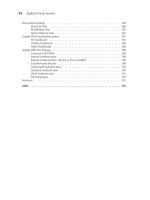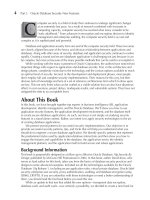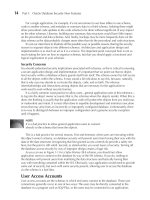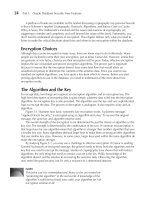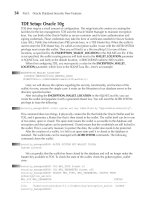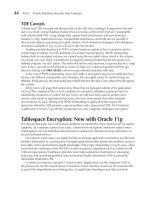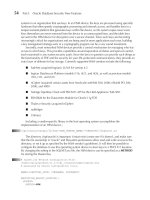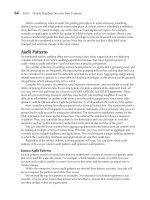Applied Oracle Security: Developing Secure Database and Middleware Environments- P4 doc
Bạn đang xem bản rút gọn của tài liệu. Xem và tải ngay bản đầy đủ của tài liệu tại đây (170.65 KB, 10 trang )
4 Part I: Oracle Database Security New Features
omputer security is a field of study that continues to undergo significant changes
at an extremely fast pace. As a result of research combined with increases in
computing capacity, computer security has reached what many consider to be
“early adulthood.” From advances in encryption and encryption devices to identity
management and enterprise auditing, the computer security field is as vast and
complex as it is sophisticated and powerful.
Database and application security form one end of the computer security field. These two areas
are closely aligned because of the heavy and obvious relationship between applications and
databases. Along with other areas of security, database and application security continues to evolve
rapidly. Creating a sound and secure (database) application is challenging not just because it can
be complex, but more so because of the many possible methods that can be used to accomplish it.
While working with the many customers of Oracle Corporation, the authors have noticed two
important things with respect to application and database security. First, in the architecture and
design phases, complexity exists due to the technology and the various options available to reach
an optimal level of security. Second, in the development and deployment phases, most people
don’t employ full and complete security implementations. Their reasons for this vary, but their
obvious lack of knowledge and lack of a set of reference architectures from which to draw upon
are key. This not only limits what can be crafted as a viable solution but can also have disastrous
effects in cost overruns, project delays, inadequate results, and vulnerable systems. They have not
mitigated the risks to an acceptable level.
About This Book
In this book, we have brought together top experts in business intelligence (BI), application
development, identity management, and the Oracle Database. We’ll show you how to use
application security features, the application development environment, and the database itself
to create secure database applications. As such, our focus is not simply on studying security
features in a stand-alone context. Rather, our intent is to apply security technologies to the art
of creating database applications.
We present several patterns for successful security implementations. Our objective is to
provide successful security patterns, tips, and tricks that will help you understand what you
should do to engineer a secure database application. We identify specific patterns that represent
the predominant styles used by application-database interactions and then show you how to
engage the features and capabilities in the database, the application server, the identity
management platform, and the application itself to build secure and robust applications.
Background Information
This book is purposefully designed as a follow-up to Effective Oracle Database 10g Security By
Design, published by McGraw-Hill Professional in 2004. In that book, author David Knox, who
serves as lead author for this book, takes you from the basics of database security practices and
designs to some advanced examples. Included are all the technologies available for the Oracle
Database 10g Release 1, including secure application roles, virtual private database, Oracle label
security, enterprise user security, proxy authentication, auditing, and database encryption using
DBMS_CRYPTO. If you are unfamiliar with those technologies or need a better understanding of
them, you should read the first book before you read this one.
While an update to that text that added the new options—transparent data encryption,
database vault, and audit vault—was certainly a possibility, we decided to create a new book for
C
Chapter 1: Security Blueprints and New Thinking 5
two main reasons: First, identity and access management advances were needed to form any
significant and complete description of security. Second, the goal of this book is to show how you
can apply those base database technologies to secure database applications such as the business
intelligence and Application Express (APEX) applications. Adding the new options, the identity
management sections, and the application examples would have made the book too large for
practical purposes.
In summary, the first book explains the basics of Oracle Database 10g R1 to help the reader
understand what the available security technologies can do, and then it shows how to get them
working. This book adds information about new technologies and applies all the security
technologies to the task of building secure database applications.
Every attempt has been made to abstain from redundancy with material presented in the first
book. Since we did not want to force the reader to refer back to that book too much and too often,
parts of that text have been borrowed and placed in the appropriate places to enhance discussions.
Our goal was to make this a complete and stand-alone guide that was not too voluminous.
Organization
The book starts with a discussion of the new technologies that were added since the completion
of the first book, such as transparent data encryption, audit vault, and database vault. From there,
we move out, first to the application server infrastructure and identity and access management.
This information is important to understanding what other things an application developer and
security administrator need to know when constructing security-conscious applications. We next
move out to APEX and finally the Oracle Business Intelligence Suite (OBI).
APEX is a popular platform for developing light-to-medium–weight Oracle Database
applications. Its popularity is driven by the fact that it is free to use and is tightly integrated with
the database, thereby allowing any DB-knowledgeable person to create powerful and elegant
database applications. This is a sweet spot, as many database gurus are not too familiar with
other development platforms.
APEX also represents a popular application architecture. It deploys to the Web, and the
application developers and users can connect to the database using shared and proxy schemas.
APEX also manages much of the application-level security itself. Both of these aspects make APEX
a prime case study and valuable aid in understanding how to work with those types of architectures.
OBI is popular and represents a standard way that people interact with Oracle Database.
Learning the integration and synchronization points between the BI server and the Oracle Database
security technologies proves a valuable, and more importantly, a repeatable lesson in securely
connecting applications to the database.
In Chapter 1 we explain our top motivation for writing this book—namely, technology
changes have been made to match developer and user behaviors for building and using secure
database applications. This is a major theme behind the new technologies discussed.
The discussion then moves to the primary drivers for security. These security motivators are
important because they imply what needs to be done to “secure” your database applications.
More importantly, they identify the design and business goals that need to be satisfied to ensure
that the applications meet an acceptable level of security standards. Put another way, the motivators
help you define your business and technical targets. If you cannot reach specific goals, you cannot
determine whether you have achieved success. You need to be able to answer the question, Is it
secure enough? To do this, you must understand what you need to accomplish and why. Your job
is to ensure that the applications and security implementations are aimed at the proper targets and
thereby satisfy your business and technical goals.
6 Part I: Oracle Database Security New Features
The security motivators give way to four principles for implementing security correctly. The
products, technologies, and blueprints discussed throughout the book are aligned with these
principles. The chapter concludes with concrete examples of the architectural evolution of database
security. In analyzing applications over the years, we have noted three main blueprints or design
patterns that people have employed to varying degrees of success. We examine those patterns and
analyze the pros and cons. This serves as a basis for future chapters, where we will build and connect
various database applications. You will see the common architectures and best practices for each.
Database Security Today
Database security has changed radically over the years. In some ways, it has outpaced the
growth of the general security market. The creation of record-level access via transparent query
modifications—aka virtual private database—and the ability to perform conditional auditing—aka
fine-grained auditing—are two examples of these changes. However, there is another side to this
discussion, because we have to recognize that many of the design patterns and the Oracle products
and technologies are focused on an era about 15 years ago—the mainframe and client-server days.
To achieve the security designs required for today’s environment, you must understand not
only how things work but also why they work. The intent of a product or technology is the first
clue in understanding its usefulness and applicability to your current projects. This book applies
(security) technologies to the problems and architectures used today. Before we get into that,
though, you need to understand how technology has evolved.
Evolving Technologies
Simple technology models have always been used to explain complex systems, and a model can
be used to explain security as well. Security can be described as an understanding of who gets
access to what, from where, when, and how. Physical security and digital security are largely
focused on the ability to control all aspects of people and things interacting with people and things.
With this in mind, consider how security has evolved as technology has evolved. Security
implications center around two things: user identification for auditing and accountability purposes,
and access controls to allow or prevent users from performing specific actions or accessing specific
data. In sequence, we tend to think of the security process as identification and authentication—
who (authorization and access controls) gets access to what, from where and when; and how (via
auditing). Let’s translate this into how Oracle technology has evolved over time.
In the early years, much of Oracle’s security was based on the concept of a database user, in
which the user logs in directly to the database and has a private, dedicated account. As you know,
in an Oracle database, a user and a schema are considered one in the same. The reasons for this
are numerous, but for the security architect, this can pose a few problems. Access controls and
auditing in the Oracle database are optimized for the notion of users connecting directly to database
schemas. The problem is, however, that building an application today is different from what it
was when many of the baseline security models were designed.
While appropriate at the time, direct database logins have given way to connection pools
and middle tier applications running on application servers that in many ways break the direct
association of an end user and a database user. Furthermore, as you will see, a significant
manageability challenge exists in creating and managing individual database accounts for
individual application users who just happen to be accessing an application that uses the
database.
Chapter 1: Security Blueprints and New Thinking 7
Proxy Authentication Addresses Secure, Fast DB Connections
Oracle has slowly acknowledged this pattern over the years, and it has changed its technology
as a result. Proxy authentication allowed developers to use connection pools and start lightweight
database sessions for end users. This solved the challenge of quickly connecting many users to
a database.
A problem still persisted, however, because the proxy call required the user to start a session
with an existing database account, meaning that while proxy authentication solved a performance
challenge presented by the connection pool architecture (and it did so securely by not requiring
the connection to maintain the end user’s password), it did not address user administration and
management issues. That was addressed by enterprise user security, and proxy authentication
supported that architecture as well. Manageability is an important principle in achieving an
effective security implementation.
Enterprise User Security Addresses Manageability
To adapt the technology to meet the challenges of managing large-scale user populations, Oracle
created Enterprise Users, a major step forward. The end users (or application users) are managed
in a central Lightweight Directory Access Protocol (LDAP) repository. The directory includes an
entry for each user that maps the user to a shared database schema. Also included in the user’s
entry are role mappings. This effectively gives us centralized administration and, to some extent,
centralized authorizations.
The ability to grant and manage authorizations was not totally complete, however, as database
roles in Oracle Procedural Language/Structured Query Language (PL/SQL), or definer’s rights,
procedures were disabled. Definer’s rights procedures still provide the default model and is the
prominent mechanism, if not the most popular one, for granting user privileges. As the roles were
disabled from within any executing (definer’s rights) procedure, any privileges assigned to the
roles were unavailable, thereby rendering the roles useless, a less-than-optimal solution for
privilege management. While invoker’s rights procedures remedied this problem, many applications
did not employ them and many architectures today have failed to incorporate them. Nevertheless,
centralized user management resolves many of the user manageability challenges and has made
Enterprise User Security a very useful architecture.
With enterprise users, identity preservation occurred, but just barely. Identity preservation
means that you are able to preserve the identity of the end user from source application all the
way to the database. You can then implement security and auditing controls on a user level. There
are two problems with this, however. First, the DB security and auditing work at a schema level—
that is, the identity of the user—is presumed to be the schema. Security is all too often implemented
with some reliance on a SELECT USER FROM DUAL. You could, however, write your own fine-
grained security via virtual private database, oracle label security, encryption, views, triggers and
so forth. (This sentence probably should not say could write; it should say must write. Otherwise,
you have no way of applying different security enforcements for users sharing the same database
schema.)
The second issue—and perhaps the more important issue—concerning identity preservation
is that security architectures of tomorrow, which to some extent we are already seeing, do not
use end user identity as the sole mechanism for access enforcement. These security and control
mechanisms will be based on many factors, of which the user’s identity may or may not be a
relevant piece. End user identity by itself is useful mostly for auditing purposes and not so much
for security and access controls.
8 Part I: Oracle Database Security New Features
Security and access controls today and tomorrow will largely be based on authorization models
that use roles, group memberships, and data attributes. This is because the users in many situations
are unknown not only to the database, but sometimes even to the application! Therefore, no user
entry will exist in an application’s USERS table (for example), nor will an entry exist in the Oracle
Database USER$ table and perhaps not even in the local LDAP directory. With no user entry,
you have no access control list (ACL). Without a way to capture users ahead of time, identity
is meaningless for security enforcement purposes.
To help you understand a bit better, consider an example that consists of a Web services
architecture that federates or makes many calls as part of a single business transaction. Each of these
services may be on separate servers, using separate databases, providing separate information for
separate and potentially shared purposes. As such, the ability to execute a multi-call transaction
requires some way of conveying to all the services, and subsequently the programs that access the
databases, that the user is authorized or unauthorized to perform an action. Ideally, this model
needs to support an infinite number of users and needs to be as adaptable as the standards on which
it relies. The actual user identities will therefore not be stored locally. Authorization information and
other aspects about the data and how the information is being accessed or used will be employed to
ensure that proper access is controlled. User identities, if properly propagated, will be used only for
auditing and accountability reasons.
Hopefully, you now are starting to see the new thinking of today. These highly distributed
architectures supporting vast numbers of unknown users are forcing radical changes in architectures
and implementations. In addition, another paradigm shift concerns how you address security
concerns: What are these concerns? How do you know if your data is secure? What are you
protecting and why? You can address all these questions by looking at what motivates the security
end of businesses today.
Security Motivators
It used to be that to sell security, you had to sell security. That is, other than a few exceptions for a
few customers, security was considered a nice-to-have luxury that might be considered at the end
of a development cycle when and if enough money and time remained. In fact, most data was not
considered sensitive and therefore not worth the effort to secure.
Many people used fear, uncertainty, and doubt (FUD) as primary tools to motivate people to
adopt a good security posture. Statistics of insider attacks, network packet sniffing, and computer
security hacks could create a level of anxiety sufficient for people to take proactive actions to
protect their data. Many times, however, the statistics were insufficient in motivating anyone to
do anything. The threat did not seem viable or the examples were irrelevant to the business of the
day for that specific organization.
Today’s world has radically changed its temperament on security—what it means and how to
do it. With service oriented architecture (SOA) representing today’s major infrastructure thinking,
and business intelligence, collaborative, and social Web 2.0 technologies representing higher
order thinking, maintaining a security environment to protect people and assets is just not at the
top of the list from an IT viewpoint. But security can be viewed another way, and this has
everything to do with the sensitivity of data, the pervasiveness and exposure of data, and the
consequences for not sufficiently protecting the data.
Many people now believe that security is more important than ever for two major reasons.
First, the primary drivers have shifted, from acting out of fear of direct data theft of hard-to-find
and hard-to-obtain information to complying with government and regulatory policies set up to
Chapter 1: Security Blueprints and New Thinking 9
protect information that at one time was not considered sensitive but today is considered highly
sensitive. Personally identifiable information is a prime example of such data. The explosion of
information and information use has increased the need for security.
The second reason for an increase in the importance of security centers around the results and
negative impacts that a compromise or data breach can have on an organization, its reputation,
the future employability of those considered accountable, and the always motivating financial
penalties and threat of incarceration. A lot of data needs to be protected. This data is shared,
transmitted, transferred, analyzed, and integrated, and each action represents an increased risk
of compromise. With compromise comes demise. With corporate brands and public perception
influencing stock prices and future viability, security is indeed more important now than ever.
Let’s explore a little more deeply to clarify this sensitive information and consider how we
should protect it.
Sensitive Data Categorization
To satisfy a security requirement properly, you must identify what you are protecting, from whom,
and why. By understanding the characteristics and use of the data, you can then understand its
vulnerabilities and subsequently derive a plan to protect it.
At a high level, many organizations today break up their data into four top-level categories:
Personally identifiable information
Protected health information
Intellectual property
Data within the realms of governance
Personally Identifiable Information
The first category, personally identifiable information (PII), includes any information that can be
used to obtain or create a false identity. It includes names, addresses, Social Security numbers,
and other private information that can be used for nefarious purposes as a way to spoof or pretend
to be someone else. The alarming thing about PII is that it is data about people—not just special
people such as celebrities and politicians; it is data about essentially everyone. Furthermore, this
data is used many times a day to perform the most mundane tasks, such as paying bills, registering
for a license, applying for a loan, and applying for a job. These are just a few examples of where
highly sensitive personal information can be found.
Identity theft is a growing concern, and organizations are struggling with ways to protect the
identities of their customers, employees, and partners. Fortunately, some best practices for how
to protect PII are developing, and these will be discussed in later chapters.
Protected Health Information
Protected health information (PHI) is privacy information that deals with a person’s health or
medical conditions. It is more formerly described and governed in the US Health Insurance
Portability and Accountability Act (HIPAA).
PHI pertains not just to healthcare providers (such as hospitals) and healthcare payers (such
as health insurance companies). Many organizations collect some PHI, and this data is scattered
throughout their IT systems in employee benefit submissions, paid time off, disability insurance,
and so forth.
■
■
■
■
10 Part I: Oracle Database Security New Features
The challenge here is to employ the correct amounts of security to protect the individuals’
privacy without hampering the general business flows necessary to operate an organization
efficiently. Authorized persons must be able to perform authorized tasks easily, and unauthorized
persons should not be able to perform unauthorized tasks easily. The issue regarding ease of use
has to do once again with human behavior and incorporating security controls in a transparent or
unobtrusive way. This is particularly important in day-to-day tasks and applications that support
such things such as HR applications and customer relationship management (CRM) applications.
Intellectual Property
Safe guarding proprietary information in a growing and global economy is more important today
than it has ever been. Trade secrets, business transactions, and merger and acquisition strategies
are among the top information categories that organizations are struggling to secure.
Often, organizations will (and should) create classifications around the data. Federal governments
use classification schemes all the time to help control their information. Confidentiality markings are
used to dictate the handling procedures of the data. It may be that some information is not permitted
to leave the company, or information can be shared only with a partner who has signed a
nondisclosure agreement, and so forth.
What makes this information difficult to secure is that large amounts of information in many
forms is distributed to many people for many reasons. As it flows through different media to
different people, it becomes increasingly more difficult to control and thus secure. In this book,
we will keep our discussions simple while maintaining the point that this category of information
is as important as it is large—it concerns lots of data and lots of people.
Governance and Regulations
The biggest challenge that has everyone’s attention centers on financial statements in regards
to the Sarbanes Oxley (SOX) Act of 2002. As a result of several disastrous events, the legislation
holds companies accountable for the precision and authenticity of their financial statements. This
is by no means a legal definition, as one is not required here, but suffice it to say that legal penalties
can be levied for noncompliance. However, the results of illegal disclosure are often more important
outside the legal domain. A publicly traded company’s reputation, branding, and public image
are constantly at stake. A negative event can have disastrous effects on stock prices and the future
viability of a company.
The challenge for this scenario arises from several factors, among them are ensuring the
timeliness of reporting the financial information, controlling access to the information, and naturally
trying to guarantee that the information is accurate. Once again, this involves a must-have need
to manage who gets access to the internal data and under what conditions.
Principles
Regardless of the classification of data and the need to protect it, you can adhere to a few
principles when considering a solution to a business problem and contemplating the correct level
and appropriateness of security. These principles are adaptations and evolutions of those cited
in Effective Oracle Database 10g Security By Design. These principles should serve as guidelines
to help you drive decisions and effective postures and are echoed throughout the book.
Understanding them and why they are important is essential to your understanding the
complementary technologies, architectures, and best practices presented herein.
Principles can serve to prove due diligence or, in some cases, negligence. Incorporating
security is a delicate balance of preserving ease of use, performance, and manageability. As these
factors often compete with security, it is important that you are able to justify and implement a
Chapter 1: Security Blueprints and New Thinking 11
balanced, prudent, and rational solution. Discounting security entirely is rarely, if ever, an option.
The point is for you to be able to prove that the correct level of security is being implemented in
the correct way. Doing so may assist you in preserving company brand, reputation, and viability
and also in protecting your reputation and employability.
Layers of Security
You probably know that dressing in layers of clothing is a prudent approach to staying warm in
places where the weather can change quickly and dramatically. Security in layers has an analogous
benefit. A removal of one layer—say, by compromise—does not expose the entire system. When
you look at how to apply security, you want to look at incorporating multiple layers whenever it
makes sense to do so. There is no such thing as being too secure (which should not be confused
with too cumbersome a security implementation to be usable).
Of all the things that compete with a security implementation, other security implementations
should not be one of them. In fact, quite the opposite is true. The more, the better is the suggestion
as long as it does not present a significant cost in money, time, labor, effort, or performance. While
that may seem an impossible task, it is not. New technologies such as Transparent Data Encryption
(TDE) can add a layer of security, thereby increasing security and keeping coding to a minimum,
along with minimal costs, effort, and performance degradation.
Another best practice is to apply a security layer as close to the data as possible. This is an
optimization technique in that it allows you to get the biggest return for the effort. If the data can
be secured in the database, then do it there. This will ensure that a data security layer is available
to anyone accessing the data. Adding security at the middle tier (application server) and within
the application itself are the complementary steps advocated in a best practices doctrine.
Manageable Security
As alluded to already, being able to set up, develop, deploy, control, and adapt security is critical
to any successful security strategy. You may initially look at these desirable qualities and decide
that they are impossible to realize. But you will find ways to move toward effective security
management, and you will ultimately achieve a better solution.
In fact, common ways for achieving manageable security have already been realized.
Centralization of identities and authorizations—aka identity management—uses this very
principle as its selling point. Centralization of security is in fact a major facilitator in managing
security efficiently. The problem is that you cannot always consolidate everything into a single,
centralized environment. You will see how technology has adapted to this reality and ways in
which you can get the benefits of single control with the reality of distributed and autonomous
applications and enforcements.
Business Congruency
The next principle to achieving security success is in aligning it with existing business policies
and technology architectures. If the business needs analytical tools to investigate the deep
meaning and relationships of its data, then the security needs to align with how those tools
function and how the users are accustomed to using the application. You will see this incorporated
into BI applications.
Another example of this comes from the predominant architecture of the day—SOA. Although
this book is not about SOA, we will simply say that the goodness that SOA represents lies in its
inherent ability to allow anyone to link into any service, from anywhere, at any time. The security
challenge lies in protecting anyone from linking to any service, from anywhere, at any time. The
point here is that SOA exists and will continue to exist, and to work securely in it requires an
implementation that is congruent with how this architecture is basically employed. You’ll see that
12 Part I: Oracle Database Security New Features
you can leverage the identity management components and implement techniques that are aligned
with many SOA designs.
Transparency
You already know that changing behavior is more difficult than adapting technology. A simple way,
then, to employ new technology, and specifically security technology, is to make it transparent.
Barring any substantial issues in manageability and performance, transparency will ensure a
successful implementation. It practically eliminates the usability issues often associated with an
unsuccessful security implementation. Transparency may allow users to continue to behave as
always, without your needing to give up the ability to insert enhanced security controls and
auditing.
Throughout this book, you will read how many of the technologies have incorporated these
principles in their design, creation, and implementation. You should take these concepts and
apply them to your thinking, designs, and implementations.
Modeling Secure Schemas
There are many aspects to creating a secure database application. Here we will cover a “jugular”
topic that at first seems basic, but is in fact a bit thought-provoking. Our goal here is to answer
what seems to be a simple question: When building and deploying an application, which schema
do users connect to in the database? As you will see, the answer to this question has the greatest
security implications on your overall design.
Two important points need to be made here. First, by understanding these models now, you
will save development time in the future, as you will not be agonizing over what is the proper
way to set up your application-database connections. If you don’t agonize over such decisions
today, employing the logic presented here will allow you to create more secure applications—
because we have already agonized over the matter.
The second objective is to address the case that you are not architecting a new application
but rather installing, maintaining, or securing some other application—that is, a third-party or
architected application developed by someone else. The objective here is to provide you with the
information you need to ascertain the correct risks in such designs and provide initial guidance
on what you might do better to fortify the design.
In later chapters, we will use the information presented here to create or modify our schema
models. Defining these models now as a reference will provide consistency for the remaining
parts of this book. It will also provide a meaningful baseline to your future design and
development endeavors.
Schema Profiles
As mentioned earlier, the Oracle Database does not differentiate between a user and a schema.
That is somewhat disappointing, because those two things are remarkably different, especially
when security is concerned. In this section, you’ll see that this is actually somewhat trivial to
overcome once you develop a reference methodology for thinking about your application and
database design.
Within the database, you can think of the database users or schemas as serving some distinct
purpose. For starters, you can generally separate users from database objects. User accounts are
the schemas in which end users connect to the database. Schemas then can be loosely defined as
a collection of data, objects, procedures, and so on.
Chapter 1: Security Blueprints and New Thinking 13
Note that we are not suggesting that only two schemas are involved, only that it is logical to
break them into these two broad categories. This argument is based on the design practice that
says it’s best to separate accounts by purpose and function. This not only simplifies the design
logically and intuitively, but it also improves security. It is a basic database design best practice
that rationalizes the overall database architecture and simplifies many of the database operations
such as backups, version control, and patching.
The security angle to separate database accounts is based on the well-known and well-practiced
security tenet that says you should always maintain least privileges. This tenet was well described
in Effective Oracle Database 10g Security By Design, which summarized least privileges as the
following: “Least privileges means you give people only the permissions they need to do their job
and nothing more: you give them the least amount of privileges.” One of the easiest ways to
compromise a system is to exploit accounts that have been granted too many privileges.
Using this as your driving factor, you can start to categorize your database accounts into one
of the following two:
Object owner accounts The schemas that hold application code, logic, and data
structures
User access accounts The schemas to which users connect when they execute
application code and query and update application data
Note that for user access accounts, a direct correlation exists between user, function, and
security privileges. Users and thus schemas perform some specific function, and each function
requires privileges. For simplicity, you can group users/schemas by functional role, which will
naturally require a set of security privileges.
Object Owner Accounts
Object owner accounts are the accounts that you typically think of when you think of database
schemas. The accounts serve as a container for execution code and other database objects such
as tables, views, indexes, triggers, and so forth, that are part of an application or database option.
The default database accounts that end in “SYS”, which includes the schema SYS, are examples of
object owner accounts. These accounts are often synonymous with a database option. For example,
CTXSYS is the schema for the (Con)Text database option, MDSYS is the schema for the Spatial
data option, and SYS is the schema for the database engine itself.
Putting the objects together makes certain tasks such as patching and backup and recovery
activities easier to do. It also simplifies some code writing, as object resolution, object creation,
and object access can be accomplished without requiring any further privileges—meaning that if
you can create a table in your account, then, barring any fine-grained access controls, you can
also read from it, write to it, and drop it.
The first practice, then, is to identify and separate the object owner accounts into meaningful
yet distinct schemas. Depending on the size and complexity of the application, it may have from
one schema to many, many schemas.
The difficult part is deciding at what level to break apart the code and objects into other
(related) schemas. At first, keeping everything in a single schema might appear to be the simplest
thing to do. However, you might later find this suboptimal for supporting many tasks such as
patching, backups, administration, and, for our purposes, providing access and security.
■
■


